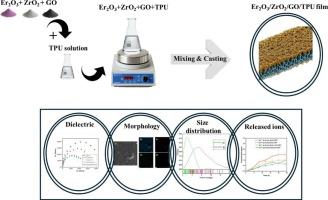陶瓷Er2O3/ZrO2纳米颗粒的发展促进了TPU/GO复合材料在柔性光电和电容器领域的应用
IF 5.4
3区 化学
Q1 CHEMISTRY, INORGANIC & NUCLEAR
引用次数: 0
摘要
聚合物介电材料在大功率应用中很有吸引力,但能量密度低,介电常数、击穿强度和机械完整性之间存在权衡,填料-基质相容性差和团聚更加剧了这一问题。在本研究中,热塑性聚氨酯(TPU)通过掺入各种纳米复合材料,包括Er2O3/TPU, ZrO2/TPU, Er2O3/ZrO2/TPU和Er2O3/ZrO2/GO/TPU。目的是分析每种复合材料对TPU薄膜的影响,以期在介电表征方面取得优异的性能。采用溶液浇铸法制备了TPU介电复合材料。利用x射线衍射(XRD)研究了薄膜中不同相的晶体结构。Er2O3/TPU、ZrO2/TPU、Er2O3/ZrO2/TPU和Er2O3/ZrO2/GO/TPU的晶粒尺寸分别为33、31.9、32.8和32.9 nm。然而,通过扫描电镜,Er2O3和ZrO2的平均团聚尺寸分别在8.08 μm和5.3 μm左右。利用红外光谱和拉曼光谱研究了纳米填料的结构和元素特征。此外,利用热重法(TGA)研究了Er2O3/ZrO2/TPU和Er2O3/ZrO2/GO/TPU纳米复合材料在20 ~ 600℃温度下的热性能。测量了所有样品的力学性能。在试样加载过程中,氧化石墨烯填充纳米复合材料的抗拉强度达到51.86±0.65 MPa,断裂伸长率达到636%±25,杨氏模量为3.75±0.53 MPa,硬度为84±0.31。因此,与其他样品相比,含有TPU/Er2O3/Zr2O和GO的样品在室温下具有更高的ε′。然而,纯TPU的ε′最低,这意味着偶极子浓度最小,材料表现出介电行为。与其他样品相比,含有GO的样品的电导率提高了1.3倍,这表明GO增强了薄膜的电导率。与纯TPU相比,含有Er2O3的TPU样品的介电常数(ε′)增加了1.15倍。本文章由计算机程序翻译,如有差异,请以英文原文为准。

Developments of ceramic Er2O3/ZrO2 nanoparticles boosted TPU/GO composite for flexible optoelectronic and capacitor applications
Polymer dielectric materials are attractive for high-power applications but suffer from low energy density and a trade-off between permittivity, breakdown strength, and mechanical integrity, which is exacerbated by poor filler–matrix compatibility and agglomeration. In the present study, thermoplastic polyurethane (TPU) is incorporated through the incorporation of various nanocomposites, including Er2O3/TPU, ZrO2/TPU, Er2O3/ZrO2/TPU, and Er2O3/ZrO2/GO/TPU. The objective is to analyze the impact of each composite on TPU films, aiming to achieve superior performance in dielectric characterization. TPU dielectric composites were prepared using solution-casting technique. XRD is used to investigate the crystal structure of different phases that exist in the film. Er2O3/TPU, ZrO2/TPU, Er2O3/ZrO2/TPU, and Er2O3/ZrO2/GO/TPU showed crystallite sizes of 33, 31.9, 32.8, and 32.9 nm, respectively. However, by using SEM, the average sizes of agglomeration of Er2O3 and ZrO2 were measured at around 8.08 μm and 5.3 μm, respectively. FTIR and Raman spectroscopy were utilized to investigate the structural and elemental characteristics of nano-fillers. Additionally, the thermal properties of the Er2O3/ZrO2/TPU and Er2O3/ZrO2/GO/TPU nanocomposites have been studied using thermogravimetry (TGA) at temperatures from 20 to 600 °C. The mechanical properties of all samples are measured. For specimen loading, GO-filled nanocomposite demonstrates the highest value of tensile strength across 51.86 ± 0.65 MPa, and the elongation at break demonstrated an improvement, rising to 636 % ± 25 with Young's modulus at 3.75 ± 0.53 MPa and hardness value at 84 ± 0.31. Hence, the sample containing TPU/Er2O3/Zr2O and GO exhibited higher ε' when contrasted with other samples at room temperature. However, the pure TPU exhibited the lowest ε', which means the dipole concentration was minimal, and the material exhibited dielectric behavior. The conductivity of the sample, which included GO, has been noted to increase by 1.3 times compared to the other sample, indicating that GO enhances the conductivity of the films. The behavior of dielectric permittivity (ε') of a sample that includes TPU/Er2O3 increased 1.15 times compared to the neat TPU.
求助全文
通过发布文献求助,成功后即可免费获取论文全文。
去求助
来源期刊

Inorganic Chemistry Communications
化学-无机化学与核化学
CiteScore
5.50
自引率
7.90%
发文量
1013
审稿时长
53 days
期刊介绍:
Launched in January 1998, Inorganic Chemistry Communications is an international journal dedicated to the rapid publication of short communications in the major areas of inorganic, organometallic and supramolecular chemistry. Topics include synthetic and reaction chemistry, kinetics and mechanisms of reactions, bioinorganic chemistry, photochemistry and the use of metal and organometallic compounds in stoichiometric and catalytic synthesis or organic compounds.
 求助内容:
求助内容: 应助结果提醒方式:
应助结果提醒方式:


